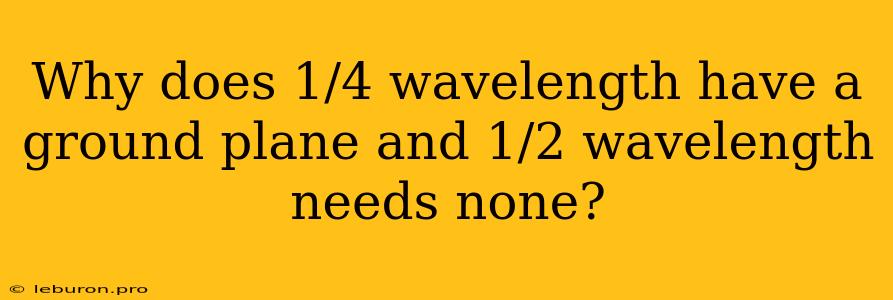The design and behavior of antennas, especially those operating in the VHF and UHF frequency ranges, are deeply intertwined with the concept of wavelength. One intriguing aspect of antenna design concerns the role of a ground plane. Why does a quarter-wave antenna necessitate a ground plane, while a half-wave antenna can function without one? This distinction is crucial for understanding the underlying principles of antenna operation and how they influence the radiation patterns and impedance matching. This article delves into the reasons behind these differences, explaining the connection between antenna length, ground planes, and the efficiency of radio wave transmission.
The Basics: Wavelength and Antenna Length
Before exploring the specific case of quarter-wave and half-wave antennas, it's essential to establish the fundamental connection between wavelength and antenna length. An antenna's length is directly related to the wavelength of the signal it's designed to transmit or receive. This relationship is key to achieving efficient energy transfer. A wavelength is the distance traveled by a wave during one complete cycle of oscillation. The antenna length is often expressed as a fraction of the wavelength, with the most common examples being quarter-wave (λ/4) and half-wave (λ/2) antennas.
Quarter-Wave Antennas: The Need for a Ground Plane
A quarter-wave antenna, as its name suggests, has a physical length equal to one-quarter of the wavelength of the signal it's intended to radiate. These antennas are commonly used in applications where a compact design is desired, such as in mobile radios or handheld devices. However, a crucial aspect of quarter-wave antenna operation is the presence of a ground plane. This ground plane acts as a reflector, effectively doubling the length of the antenna.
Here's why a ground plane is necessary for quarter-wave antennas:
- Image Theory: The presence of the ground plane creates an "image" of the antenna, which is an imaginary antenna located below the ground plane. This image antenna is essentially a mirror reflection of the actual antenna.
- Current Flow and Reflection: The current flowing through the quarter-wave antenna is reflected at the ground plane. This reflection results in a current distribution that simulates a half-wave antenna, effectively doubling the electrical length of the antenna.
- Radiation Pattern: The reflected current, in combination with the original current, leads to a radiation pattern that is similar to that of a half-wave antenna.
Without a ground plane, a quarter-wave antenna would have a very inefficient radiation pattern, leading to poor signal transmission and reception. The ground plane effectively acts as a virtual extension of the antenna, enabling it to function effectively despite its shorter physical length.
Half-Wave Antennas: Ground Plane Independence
In contrast to quarter-wave antennas, half-wave antennas can operate efficiently without a ground plane. A half-wave antenna is characterized by a physical length equal to half the wavelength of the signal it's transmitting or receiving. The primary reason for this independence lies in the inherent properties of a half-wave antenna:
- Standing Wave Pattern: The current distribution on a half-wave antenna forms a standing wave pattern. This pattern has a node (a point of zero current) at the center of the antenna and an antinode (a point of maximum current) at the ends.
- Radiation Efficiency: The current distribution in a half-wave antenna creates a radiation pattern with a maximum in the direction perpendicular to the antenna's axis. This pattern allows for efficient signal transmission and reception without the need for a reflecting ground plane.
However, it's important to note that while a half-wave antenna can function without a ground plane, including one can enhance its performance:
- Impedance Matching: A ground plane helps improve impedance matching between the antenna and the transmission line, resulting in more efficient power transfer.
- Radiation Pattern: A ground plane can modify the radiation pattern, potentially providing better coverage in certain directions.
Practical Considerations and Examples
The choice between a quarter-wave and a half-wave antenna depends on the specific application and the desired characteristics:
- Quarter-wave antennas are ideal for situations where space is limited, such as in mobile devices or handheld radios. They are also commonly used in VHF and UHF communication systems where ground planes are readily available.
- Half-wave antennas are preferred for applications where a more robust and efficient radiation pattern is desired, or where space constraints are less of an issue. They are commonly used in base stations, broadcast antennas, and amateur radio setups.
Conclusion
The presence or absence of a ground plane in antenna design is directly linked to the antenna's length relative to the wavelength of the signal. Quarter-wave antennas, due to their shorter length, require a ground plane to create a virtual half-wave antenna. Half-wave antennas, on the other hand, inherently exhibit a balanced current distribution and radiation pattern that enables them to function effectively without a ground plane. Understanding these differences is crucial for designing antennas that are both efficient and suitable for the intended application. The choice between quarter-wave and half-wave antennas, along with the inclusion or omission of a ground plane, ultimately depends on the specific requirements of the communication system.
